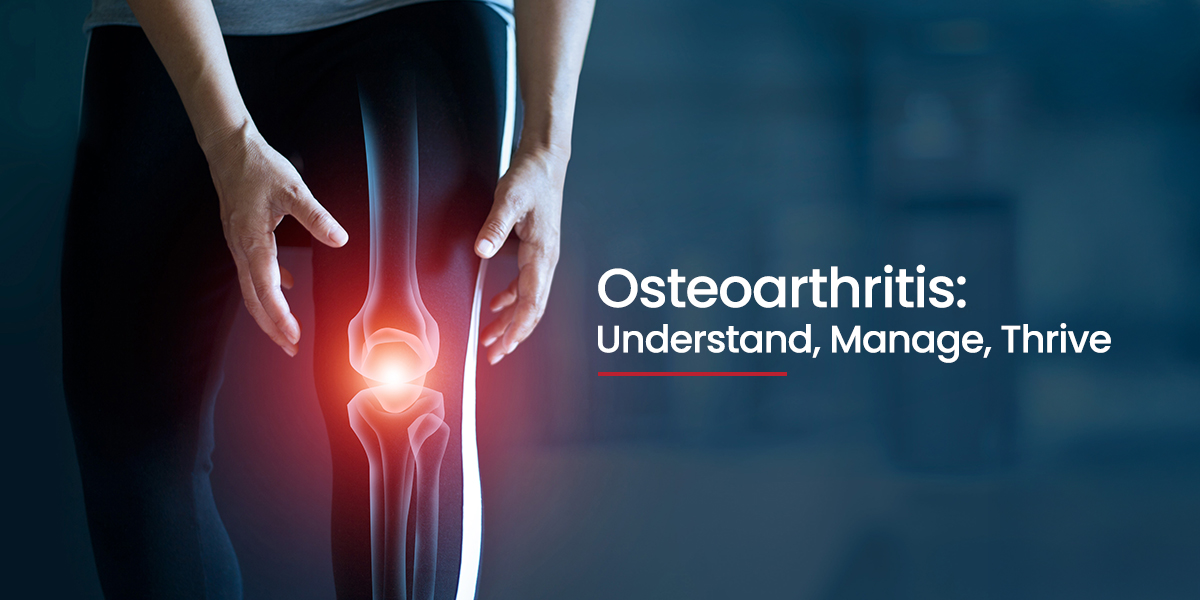What is Osteoarthritis? Causes, Symptoms, and Treatment Explained

Osteoarthritis is one of the most common forms of arthritis, affecting millions of people worldwide. This is a joint degenerative condition where the bone gradually wears down over time. This condition is most common in people over 50 years old.
Although osteoarthritis can affect any joint, it mostly affects the knees, hips, hands, and spine. It develops gradually and can cause pain, stiffness, swelling, and reduced motion. This impacts daily activities and overall quality of life.
In this blog, we will explore causes, symptoms, diagnosis, and treatment options of arthritis in detail.
What is osteoarthritis?
One of the most common questions that most people have: What is osteoarthritis? Well, it is a condition that occurs when the smooth, slippery cartilage that covers the ends of the bones in the joints breaks down. As the cartilage wears away, bones rub against each other, leading to pain, inflammation, and loss of joint function.
Causes and Risks
Let’s now discuss some osteoarthritis causes and risks.
- Age: As a person grows older, cartilage begins to wear down naturally. Thus, the risk of osteoarthritis increases with age.
- Joint injury: Previous injuries to the joint can increase your risk of developing osteoarthritis later in life. These can be sports injuries, fractures, or surgeries.
- Repetitive stress: Those whose jobs involve intense movement, such as bending, kneeling, or heavy lifting, may develop osteoarthritis due to constant stress on joints.
- Obesity: Excessive body weight tends to increase the load on the joints. This leads to accelerated cartilage breakdown in the weight-bearing joints, such as the hips and knees.
- Genetics: A family history of osteoarthritis can increase your chances of developing the condition. Some people may inherit a tendency to joint problems.
- Gender: Women are more prone to osteoarthritis than men, particularly after the age of 50.
- Bone deformities: People born with malformed joints or defective cartilage are also at higher risk of developing this condition.
Symptoms
Most people find that osteoarthritis symptoms start off mild and get worse over time. Here are some tell-tale signs to watch for.
- Joint pain during or after some movement.
- Stiffness in the morning, especially after being inactive for a long time.
- Swelling around the joints.
- Reduced flexibility.
- Cracking sound during movements.
- Tenderness near the joint.
- Hard lumps around the affected joint.
Treatments
Currently, there’s no cure for osteoarthritis; however, there are several treatments that can help manage symptoms, improve joint function, and slow the disease’s progression. Some helpful osteoarthritis treatments include:
Lifestyle Modification
You may have to lose weight if you’re overweight. Reducing weight eases pressure on the joints of the knees and hips. Apart from that, low-impact exercises like walking, swimming, or yoga can help strengthen muscles and improve joint flexibility. Additionally, alternative periods of rest with activities can prevent the overuse of joints.
Medication
In the initial period, physicians might suggest medications like paracetamol for osteoarthritis symptoms like mild pain. Anti-inflammatory drugs like ibuprofen help reduce inflammation and pain. Even some creams containing NSAIDs can provide local relief. Also, some injections are injected directly into the joint, which provides temporary relief from inflammation.
Physical Therapy
A physiotherapist can also help by guiding specific exercises to reduce osteoarthritis symptoms. These exercises help strengthen muscles around the joints, improve movement, and reduce stiffness. They might also use therapies like heat/cold therapy, ultrasound therapy, and electrical nerve stimulation.
Supportive Devices
Some assistive devices help ease your daily movements. They include braces, walkers for mobility, and special footwear for the foot and knee.
Regenerative Medicine Options
Regenerative medicine aims to restore or repair damaged cartilage and improve joint health. Some of the latest approaches include:
- Platelet-Rich Plasma (PRP) Therapy: PRP involves injecting a concentration of the patient’s own platelets into the affected joint. Growth factors from platelets can stimulate healing and reduce inflammation, potentially improving mobility and reducing pain.
- Stem Cell Therapy: Stem cells derived from bone marrow or adipose tissue may help regenerate damaged cartilage and slow disease progression. While still being researched, many patients report pain relief and functional improvement.
- Visco Supplementation: This involves injecting hyaluronic acid (a natural joint lubricant) into the knee joint. It improves cushioning, reduces pain, and enhances mobility, especially in mild to moderate osteoarthritis.
Surgical Options
Surgery can be the last option for osteoarthritis treatment. If these conservative treatments are no longer beneficial and the pain is severe, then surgery may be considered. Surgical options include:
- Arthroplasty: Joint replacement surgery commonly done for hips and knees.
- Unicompartmental Knee Replacement (UKR): Also known as partial knee replacement, UKR is suitable for patients whose osteoarthritis is limited to one compartment of the knee. Instead of replacing the entire knee joint, only the damaged part is replaced, preserving healthy bone and ligaments. This often results in quicker recovery, more natural joint movement, and less post-operative pain compared to total knee replacement.
- Spinal fusion surgery: Used for a broken or deformed spine, or conditions like spondylolisthesis, herniated disks, or chronic low back pain.
- Arthroscopy: A minimally invasive procedure to remove damaged cartilage.
Conclusion
Osteoarthritis is a long-term condition that affects the joints. It is a slowly progressing disease that can impact your everyday life. Symptoms like stiff joints, reduced flexibility, and pain or difficulty in movement can be detrimental. However, early recognition and timely medical intervention can help you take control of your joint health.
Looking for the best ortho doctor in Kanpur? Visit Regency Healthcare to consult highly experienced doctors who have been serving the state for a long time.
Also Read: Say Goodbye to Joint Pain: Top Tips for Relief and Prevention

 Call-an-Ambulance
Call-an-Ambulance



